Having had the DirectX 11 market to itself for about six months, ATI, business unit of Advanced Micro Devices, sold a significant number of cards. During that time, NVIDIA sales declined, forcing hardware makers to take unusual measures in order to reduce their GT 200 Series inventories, among other things. This did not change much with the launch of the GTX 400 line, since previous-generation NVIDIA GPUs still aren't in as high demand as they once were.
One of the products Galaxy has on display in Taipei right now is an example of such a measure, though not nearly as seemingly desperate or bound to cause stupefaction in end-users as weak entry-level cards with 2GB of low-end VRAM. What Galaxy actually put together is, essentially, a dual-GPU DirectX 11-capable GTX 480 video board with a GeForce GT 240 chip strapped onto it.
The overall specs of the device, as far as the GF100 is concerned, aren't exactly different from the original ones. The amount of memory is unchanged (1536MB) as are the 384-bit interface, the 480 CUDA cores and the rest of the feature set (3D Vision surround support, etc.). The unusual part starts with the GT 240 itself, which has 512MB GDDR5 of its own, as well as a 128-bit interface, 96 CUDA cores and compatibility with DirectCompute 4.1. Basically, this secondary chip should be able to offload all PhysX calculations, leaving the GF100 free to do graphics rendering.
An NVIDIA nForce 200 bridge chip connects both parts to the system bus via individual PCI Express x16 links. It should also be noted that the product is still fully capable of entering 4-way SLI multi-GPU configurations without affecting the GT 240 in any way. Finally, being in standalone card form, the GT 240 GPU doesn't draw additional power, leaving the overall TDP almost unchanged. Unfortunately, no pricing or availability details are available.

 14 DAY TRIAL //
14 DAY TRIAL //